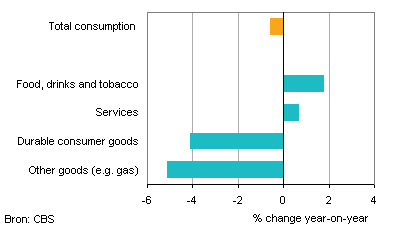Consumers spend less, confidence falls

Household spending on goods and services was 0.6 percent down in September 2014 from September 2013. Prior to the decrease, household spending had grown modestly for four months in a row. Spending on durable consumer goods and other goods (e.g. natural gas and motor fuels) declined most notably, according to Statistics Netherlands today. Consumer confidence deteriorated further in November. Consumers were far more negative about the economic situation.
Consumption figures have been adjusted for price changes and differences in the shopping-day pattern.
Domestic household consumption (volume, adjusted for shopping-days)

Spending on clothing and shoes distinctly down
Household spending on durable goods was down by 4.1 percent in September 2014 from September 2013. Consumers spent less on clothing and shoes. Last week, Statistics Netherlands already revealed that clothing sales were substantially down in September, but that consumers spent more on home furnishing articles and electronics.
Dutch consumers spent 1.8 percent more on food, drinks and tobacco products, whereas spending on other goods (including natural gas and motor fuels) was down by 5.1 percent relative to September 2013. Household spending on services grew by 0.7 percent. The sector services accounts for more than half of domestic consumer spending.
Domestic household consumption by category (volume, adjusted for shopping-days), September 2014

Circumstances for consumption deteriorated in November
On balance, circumstances for consumption have deteriorated in November according to the Household Consumption Radar, mainly because Dutch manufacturers were far more pessimistic about future employment in their sector and more negative about future unemployment.
Consumers far more negative about the economy
Consumer confidence dropped by 5 points in November to - 8. Consumers were much more negative about the economic situation. Consumer confidence in November is at the same level as its long-term average over the past two decades. With 27, consumer confidence reached the highest level ever in April 2000 and reached its lowest point in February 2013 (- 44).
Consumer confidence, seasonally adjusted

More negative about the economy, willingness-to-buy remains stable
The component indicator Economic climate fell 12 points to - 4. Consumers’ opinions about the economic climate over the past twelve months and the next twelve month deteriorated.
From October to November, the component indicator willingness-to-buy remained stable at - 10. Consumers think that the time to do large purchases, like as washing machines and television sets, is about just as unfavourable as in the preceding month. Their opinions on their personal financial situation over the past and next twelve months were also as negative as in the previous month.
Consumer confidence
More figures can be found in dossier Business cycle.
For more information on economic indicators, see the Economic Monitor.